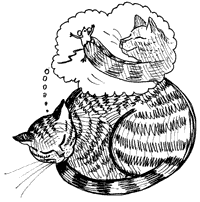STRANGE BUT TRUE- Sweet dreams: Animals have them too-- maybe

DRAWING BY DEBORAH DERR McCLINTOCK
Q. Do any other species dream in their sleep, and how would we know? They certainly couldn't tell us about it. –D. Fossey
A. Guess again. Chimpanzees, like humans, are heavily visual, and when the famous chimp Washoe was taught sign language, she would often combine the symbols for "sleep" and "pictures," says Jim Horne in Sleepfaring. Pretty impressive testimony.
Actually, almost all mammals have REM sleep, for "rapid eye movements," the period in humans of heaviest dreaming. Cats with damage to the part of their brain that inhibits movement during REM sleep would open their eyes, hiss and arch their back in mock attack– as if they were acting out dreams. (Humans with "REM sleep disorder" may also act out dreams.) Many dog owners watching Fido sleep will see periodic twitchings and yelpings: A closeup look will show his eyes periodically darting about under closed lids (though dogs' dreams may be more smell driven than visual).
Who knows if marine animals such as dolphins dream, since many of them sleep one brain hemisphere at a time? "It would be strange, if not bizarre, to have one side awake and the other dreaming– how would they know what is fact and what is fantasy given that there are predators around?" asks Horne.
Q. When a face is described as turning "livid with rage," what color does it become? –S. Johnson
A. Such usage authorities as The Oxford English Dictionary and The Associated Press stylebook suggest "livid" as "ashen or pale," says Mark Davidson in Right, Wrong, and Risky. But The Merriam-Webster New Book of Word Histories notes, "An angry person is at least as likely to be red-faced as pallid," and "reddish" is currently included for "livid" in Webster's New World College Dictionary.
Historically, the word entered English in the 17th century as "dull, grayish or leaden-blue." Later, it meant "ashen or pallid like a corpse," or just "pale." But the modern sense could hardly ignore the angry facial reddening, and so the phrase "red with rage." Now, many modern dictionaries say that "livid" simply denotes "enraged," so you can supply whatever color you wish.
Q. In each case, which takes the greater human toll? 1) homicides or suicides 2) accidents or strokes 3) poisonings or tuberculosis 4) leukemia or emphysema 5) being eaten by a shark or killed by a falling airplane part 6) flying commercially or driving 7) children being abducted or dying in a car crash. –R. L. Ripley
A. In all cases, the second cause of death is more common, but most people pick the first, says Thomas Kida in Don't Believe Everything You Think. Our errors here stem from the "availability heuristic," a mental rule of thumb by which we estimate the likelihood of an event based on how easy it is to picture it happening.
Though most people think we're twice as likely to die from an accident, we're actually 40 times more likely to die from a stroke, 30 times more likely to die from falling airplane parts than from a hungry shark! Suppose you're taking a 750-mile plane trip and when your friend drops you off at the airport, he says, "Have a safe trip."
"Ironically," says Kida, "he's three times more likely to die in a car crash on his return trip than you are on your plane trip."
The point here is that images of plane crashes are more dramatic, hence flying phobias are ubiquitous, driving phobias rare. High on the list of parental worries are abductions, given constant media attention, though with only a one-in-700,000 chance of occurring; a child's car death is actually 100 times more likely.
"Sensational stories get airtime, distorting our evaluation of the risk," Kida says.
Q. When soldiers hack a path through the jungle, does the jungle fight back? –K. Cox
A. Bamboo is one of the fastest growing jungle plants, clocked at about a meter a day, fast as the minute hand of a watch, says Guy Murchie in The Seven Mysteries of Life.
It's also tough, a construction staple in much of the world where earthquakes would weaken a concrete building. The Bamboo Laboratory at Eindhoven University of Technology reports that a short, straight stalk of it just a couple inches across can support a full-sized elephant.
Murchie recalls World War II stories of soldiers laboriously chopping a road through the jungle only to find it impassable a week later, owing to the "tremendous volume and stubbornness of new bamboo shoots that had sprouted there as soon as the cutting stopped."
One army truck parked alongside a road on a Tuesday morning during a monsoon couldn't be budged by Friday night, "bamboozled" by upshoots that literally staked and wove the wheels and axles to the ground.
"If one could consider the kingdoms of nature to have been participating in the war in Burma, one would have to concede that it was the vegetables that generally emerged victorious over the humans and their mineral slaves," Murchie says.
Send Strange questions to brothers Bill and Rich at [email protected].
#